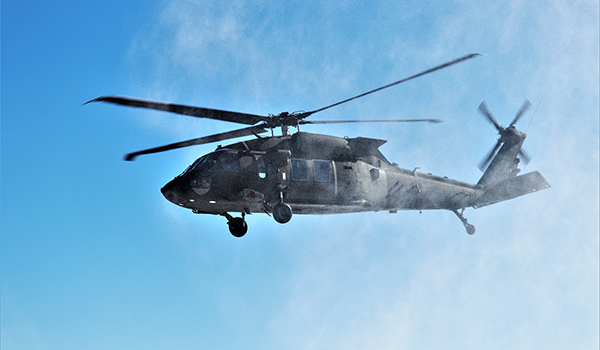
AMCOM Commander Update / By MG K. Todd Royar: I want to start by saying that I am honored and humbled to have returned to the U.S. Army Aviation and Missile Command (AMCOM).

An aircrew with the 1st Battalion, 147th Aviation Regiment of the Wisconsin National Guard at Madison operates a UH-60 Black Hawk helicopter at Fort McCoy, WI March 11, 2019. / U.S. ARMY PHOTO BY SCOTT T. STURKOL, PAO, FT. MCCOY, WI
Having just come from one of our great Divisions, I understand the importance of both the readiness of our current fleet and the criticality of getting new, sustainable, systems to the field to face future threats. You have my commitment at AMCOM in working with the rest of the enterprise to meet these goals.
Readiness
While NMCS rates have been at near historic lows, generally four to five percent per Mission Design Series, we must be strategic on what we spend our money on. In short, it is cost prohibitive to get to zero percent NMCS if we also want to invest in Future Vertical Lift (FVL). Consequently, we must do better in tackling the ever-growing gap that has developed between its field and sustainment maintenance programs. We must fully utilize the Condition Based Maintenance Plus (CBM+) strategy to bridge the gap between time between overhaul, phase inspections and depot service life extension programs by optimizing component life and available contractor resources in a way they can be most effective to current and future readiness.
At the present time, as structured, our current depot service life extension programs are not a sufficient strategy to address the legacy fleet and its challenges. In order to prevent our legacy fleet from becoming too costly we must prioritize and validate aircraft to be inducted by utilizing a CBM-enabled Airframe Inspection Maintenance and Sustainment Program. It is evident that an essential element of our strategy to maintain our legacy fleet will be to optimize the available funds and resources. This will allow the Aviation enterprise to continue to build readiness in the future with its legacy aircraft.
Modernization
In order to maintain the tactical edge in combat the Army as a whole must continue to ensure it is modernizing. The Future Attack Reconnaissance Aircraft, Future Long Range Assault Aircraft and Future and Advanced Unmanned Aircraft Systems will provide great capability, but we also want and need them to be reliable enough to keep long term costs down. In order to ensure the success of FVL and its technologies AMCOM is synchronizing with the FVL-Cross Functional Team by providing all sustainment and maintenance support throughout the life cycle of the aircraft. A key component of the approach is to build into the design a higher materiel availability rate than our current systems were designed against. Another key parameter will be to ensure we build into the design a methodology to continually review maintenance requirements and then adjust them where needed. One such system being used on our CH47F fleet is the Maintenance Steering Group, 3rd Specification. Its methodical review of data will result in decreased overall maintenance requirements for the CH-47F fleet – we will need a similar type approach on our new airframes from day one.
Reform
Finally, we need to reform ourselves and our mentality towards maintenance. While NMCS rates have been at near historical lows as mentioned above, our NMCM rates have averaged 15-20 percent. Some of this can be attributed to safety of flight maintenance requirements, yet some is also on us. As we no longer have the negative effects of leaving behind maintainers due to force manning restrictions, our thought process must change. Every maintenance action is a training opportunity and we are hurting our next generation if we do not teach, coach and train them on what right looks like. Similarly, readiness today, and not just for future deployments, counts. Although it is a commander’s call if we have parts show up late in the day to get an aircraft from NMCS to fully mission capable. Consequently, we should plan on working that same day/night to get the airframe up. This takes planning for personnel manning and shifts, but it can be done. In short, we need to change our maintenance culture from that which we practiced during the Global War on Terror to more of a fight tonight mentality for operations against a near peer threat.
In closing, AMCOM is here to ensure that Army Aviation develops in to an agile, adaptive expeditionary force needed to compete and win in large scale combat operations in support of combatant commanders. The Army
Aviation Sustainment Enterprise remains focused on maintaining our legacy fleet to ensure continued readiness, modernization and continuously educating in present time.
MG K. Todd Royar is the commanding general of the U.S. Army Aviation and Missile Command at Redstone Arsenal, AL.







